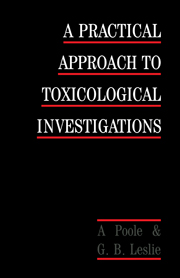Book contents
- Frontmatter
- Contents
- Foreword
- Preface
- List of abbreviations
- 1 Introduction
- 2 Regulatory requirements
- 3 Animals: sources, selection, husbandry
- 4 Standard studies in animals
- 5 Measurements and observations made in living animals
- 6 Terminal studies
- 7 Specialised routes of exposure
- 8 Reproductive toxicology
- 9 Genotoxicity
- Appendix 1 Toxicology data requirements for clinical trial approval and registration of new drugs
- Appendix 2 Countries and addresses of regulatory agencies
- Index
Appendix 1 - Toxicology data requirements for clinical trial approval and registration of new drugs
Published online by Cambridge University Press: 04 August 2010
- Frontmatter
- Contents
- Foreword
- Preface
- List of abbreviations
- 1 Introduction
- 2 Regulatory requirements
- 3 Animals: sources, selection, husbandry
- 4 Standard studies in animals
- 5 Measurements and observations made in living animals
- 6 Terminal studies
- 7 Specialised routes of exposure
- 8 Reproductive toxicology
- 9 Genotoxicity
- Appendix 1 Toxicology data requirements for clinical trial approval and registration of new drugs
- Appendix 2 Countries and addresses of regulatory agencies
- Index
Summary
This section has been included to provide a summary of the types of toxicology data required by the major regulatory authorities. It must be emphasised that it is only a summary and anyone preparing a registration dossier should refer to the original toxicity guidelines.
(Addresses of the regulatory authorities are given in Appendix 2, p.181–182.)
SINGLE ADMINISTRATION (ACUTE) TOXICITY STUDY
Australia
Animal species: At least two, one usually being a non-rodent other than a rabbit. (This requirement is not normally implemented and studies in two rodent species, e.g. rats and mice, are normally acceptable. However, if large differences in response are seen, then a third species should be included.)
Number of animals: In principle, the same numbers of male and female animals should be used. No exact number is given and a formal estimate of the LD50 is not required.
Administration route: In general, two routes of administration should be used. The proposed therapeutic route must be used in both species, with the oral route or injection in at least one of them.
Observations and examinations: Animals should be observed for not less than 10 days, usually 14, and adequate examinations should be undertaken to reveal tissue or organ damage.
Canada
Animal species: At least three species must be used (two rodent and one non-rodent other than the rabbit). Additional species may be required if large differences in response are seen.
- Type
- Chapter
- Information
- A Practical Approach to Toxicological Investigations , pp. 157 - 180Publisher: Cambridge University PressPrint publication year: 1989



